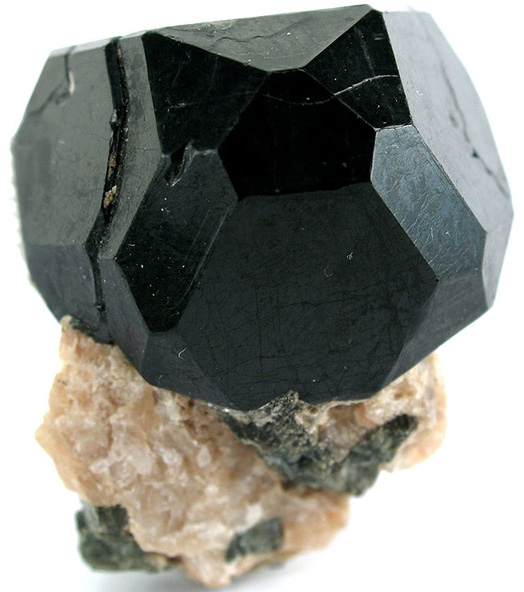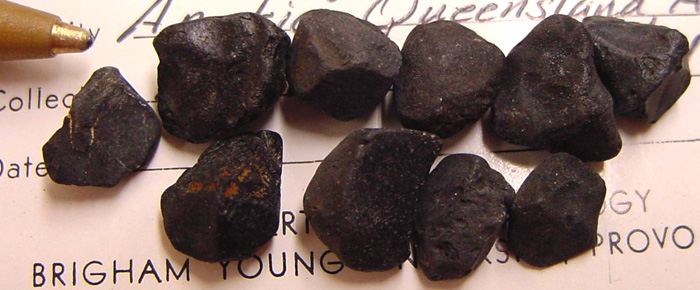Pleonast
Pleonast, also once known as ceylanite or ceylonite, is a dark colored variety of spinel.
Pleonast was described in 1801 by noted mineralogist R.J. Hauy. It is also sometimes spelt pleonaste - and although several sources state that the latter is the correct spelling, OED states that either is acceptable. Note that the gemstone named pleonast is not directly related to the word pleonasm / pleonastic, which is a literary term meaning "to use more words than necessary to describe something" [1]. In this use of the word, a pleonast is someone who habitually uses more words than necessary. Both meanings of the word have the same root in the Greek word for 'abundant' but the name of the mineral was chosen because pleonast can have many possible crystal forms. [2]

Pleonast aka black spinel
(Above): Black spinel from Eastern Siberia, Russia. Size: 2.6 x 2.4 x 2.3 cm.
Photo by Rob Lavinsky, iRocks.com - licensed under CC-BY-SA-3.0
Pleonast gemstone is somewhat obscure and neither this name nor its other name ceylonite is well known nowadays; but the stone has enjoyed some popularity as a gemstone. You may find it It was also once sometimes called pleonast ruby, and this name reminds us that the spinel was once often confused or synonymous with the ruby. In 1897 the Edinburgh Review stated that pleonast was sometimes used for mourning jewelry, on account of its often black coloration. Robert Jameson's 1816 "System of Mineralogy" described pleonast as being colored "muddy duck-blue, and greyish-black, which approaches to iron-black." [3] It is also sometimes colored dark green. [4]
Jameson went on to state that pleonast (ceylanite) was hard enough to scratch quartz, but not as hard as spinel. [3] As quartz has a hardness of 7.0 (Mohs) and spinel has a hardness of 7.5-8.0, we can deduce the hardness of pleonast to be in the range of 7.0-7.5. Jameson gives a good description of the stone. It was first discovered in Ceylon (now Sri Lanka) in 1793, and when found in crystallline form (it also occurs in amorphous or rounded masses), crystallizes as octahedrons or rhomboidal dodecahedrons. It has perfect fracture and is somewhat breakable (frangible), and has a specific gravity of 3.7647 to 3.7391. [3] Chemically, it is a "ferroan spinel" - an iron-rich intermediary in the spinel-hercynite series. [2]
Pleonast Occurrence
Pleonast has also been found in China, Japan, Slovakia, Switzerland, the USA [5], Norway [6], Eastern Siberia [7], Italy [8] and other locations , and is found in regions containing high levels of aluminum and magnesium in the surrounding rock. Specimens are often dull but gem-quality pleonast is sometimes found; most often in southern Asia. It has been found in association with hornblende, peridot, phologopite, chondrodite, calcite, and marble. [9]
Pleonast is most often now thought of as a dull, uninteresting mineral - as evidenced by the example in the single public domain image I was able to find! However, attractive specimens have evidently been found: The 1804 Critical review, or, Annals of literature of Tobias George Smollett describes pleonast found in Andernach (Germany) as a "beautiful blue stone". [10] Such material is evidently rare, as photographs are hard to come by.
Other varieties of spinel can include almandine spinel (violet to violet-blue, and not to be confused with almandine garnet), balas ruby (pink to pale red), blue spinel, flame spinel (orange to orange-red), gahnospinel (zinc rich, dark green to greenish-black), picotite (brown), rubicelle (yellow to orange) and ruby spinel (red). [11]
Pleonast is sometimes known by mineralogists as magnesioferrite and this name has been validated by the IMA as a spinel that has both magneisum and iron. However, mindat'org's listing for magnesioferrite describes the mineral as having a hardness of 5.5-6.5 (mohs), clearly quite different to that of the pleonast of Hauy and Jameson. [12]

Pleonast rough
From Queensland, Australia.
Pleonast - Sources Referenced:
[1] Oxford English Dictionary
[2] http://www.mindat.org/min-6684.html
[3] http://books.google.com/books?id=W3-7AAAAIAAJ&pg=PA26
[4] http://www.minerals.net/mineral-variety/Mineral/Pleonast.aspx
[5] http://www.mindat.org/min-9744.html
[6] http://www.mindat.org/mesg-11-166533.html
[7] http://www.e-rocks.com/Products.aspx?action=list&type=14770&showall=1
[8] http://books.google.com/books?id=QEcPAQAAIAAJ&pg=PT36
[9] http://www.kosmix.com/topic/pleonast
[10] http://books.google.com/books?id=hDwFAAAAYAAJ&pg=PA522
[11] http://www.minerals.net/gemstone/spinel.aspx
[12] http://www.mindat.org/min-2501.html
Back to the Gemstones List home page - over 160 gemstones explored!
Please feel free to link to this page - copy / paste the text below: (click to select)
Privacy Policy | Cookie Policy | GDPR | About This Site / Terms

© gemstoneslist.com


